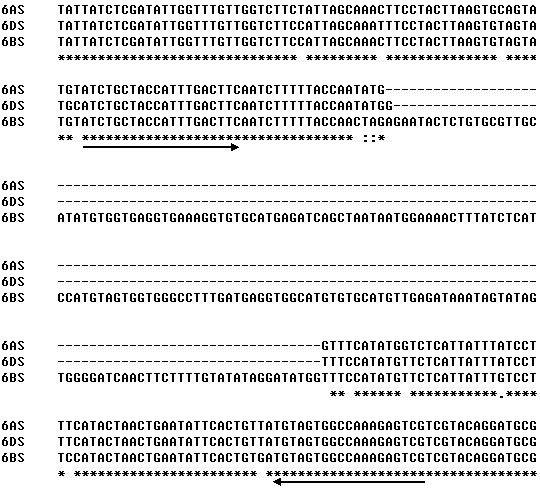Trichophyllum 6vs chromosome-specific molecular marker 6vs-bh1 and its use
A 6VS-BH1 and molecular marker technology, applied in the fields of molecular biology and genetic breeding science, can solve the problems of limited EST quantity and molecular markers, and achieve wide annealing temperature, high resolution, and good stability of PCR amplification Effect
- Summary
- Abstract
- Description
- Claims
- Application Information
AI Technical Summary
Problems solved by technology
Method used
Image
Examples
Embodiment 1
[0023] Example 1: Design and synthesis of primers
[0024] powdery mildew resistance gene located on chromosome 6VS Stpk-V (GeneBank accession number: HQ864471) BLAST was performed to find the homologous gene Bradi3g04940 in the wheat model plant Brachypodium distachyon (GeneBank accession number: XM_003575353, GeneID: 100840649). Centering on the homologous gene Bradi3g04940 in Brachypodium distachyon, its upstream and downstream sequences were obtained from the NCBI website (http: / / www.ncbi.nlm.nih.gov), and in the wheat genome (http: / / wheat-urgi .versailles.inra.fr) to obtain sequences located on the short arm of the wheat homology group VI (6AS, 6BS, 6DS), and perform multiple sequence alignment analysis on these homologous sequences, according to Design 5 pairs of specific primers for the conserved sequences on both sides of the length polymorphic region in the comparison result (see figure 1 , Table 1), primers were synthesized by Shanghai Jierui Bioengineering Co., ...
Embodiment 2
[0027] Example 2: Screening of the 6VS chromosome-specific marker 6VS-BH1 of T. villosa
[0028] (1) PCR amplification: T6VS.6AL ( Pm21 gene), translocation line T6VS.6DL ( PmV Gene), hard cluster wheat, etc. as materials (the materials used are provided by Nanjing Agricultural University and Jiangsu Lixiahe Regional Agricultural Science Research Institute, all of which are well-known and public germplasm materials). After the genomic DNA is extracted, PCR amplification is performed. Contains about 10-20ng template DNA, 1×PCR buffer, 1.5mmol / L MgCl2, 200mmol / L dNTP, the final concentration of the two primers is 0.2µmol / L, 0.5U Taq DNA polymerase, supplement the reaction with sterile distilled water The PCR reaction program is: 94°C pre-denaturation for 3 minutes; 94°C denaturation for 20 seconds, 60°C-66°C annealing for 30 seconds, 72°C extension for 60 seconds, 32 cycles; 72°C extension for 5 minutes; 4°C storage .
[0029] (2) Detection of PCR products: PCR amplificatio...
Embodiment 3
[0034] Example 3: Molecular marker 6VS-BH1 traces the translocation line T6VS.6AL ( Pm21 gene) on the 6VS chromosome
[0035] Powdery Mildew Resistant Wheat-T. villosa Translocation Line T6VS.6AL ( Pm21 gene) and powdery mildew-susceptible Yangmai No. 9 (provided by Jiangsu Lixiahe Regional Agricultural Science Research Institute, which is a known public germplasm material) to construct F 2 The genetic population was inoculated with powdery mildew at the second-leaf stage, and the resistance and susceptibility phenotypes were identified, and each individual plant was identified with the molecular marker 6VS-BH1. Only the bands corresponding to 6AS and 6DS were amplified in the susceptible individual plants, but no specific bands of 6VS-Pm21 were amplified. In disease-resistant homozygotes, only 6DS and 6VS-Pm21 specific bands are amplified, while disease-resistant heterozygotes can simultaneously amplify three bands of 6AS, 6DS, and 6VS-Pm21 (see figure 2 ). This result...
PUM
 Login to View More
Login to View More Abstract
Description
Claims
Application Information
 Login to View More
Login to View More - R&D
- Intellectual Property
- Life Sciences
- Materials
- Tech Scout
- Unparalleled Data Quality
- Higher Quality Content
- 60% Fewer Hallucinations
Browse by: Latest US Patents, China's latest patents, Technical Efficacy Thesaurus, Application Domain, Technology Topic, Popular Technical Reports.
© 2025 PatSnap. All rights reserved.Legal|Privacy policy|Modern Slavery Act Transparency Statement|Sitemap|About US| Contact US: help@patsnap.com



